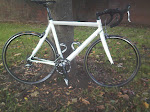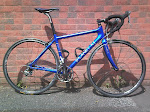I speak to many people and have seen many posts on forums saying how boring turbo training is, and these people use this as an excuse for not using one. Simple fact of the matter is that a turbo trainer is a fabulous tool to bring on training effects and also measure those effects and those who refuse to use one are, in my opinion, missing out.
Let's address the above point first - turbo training is boring. Or is it simply that these people try to replicate on the turbo what they do on the road, ie get on and ride for 60 minutes at a steady pace (or 3 hours if your name is Hussler and you're in the Falklands!). Yes, this would be dull and to be honest when I started riding the turbo some 3 years ago the "40 minutes at 80% of MHR" was the session I looked forward to least. So, keep the steady rides for the road and use the turbo for interval training, easy recovery sessions or for when the weather is really bad. For interval training, the turbo becomes a different beast, an instrument of torture known in some cycling circles as "The Rack", but it is fabulously effective as such and if you have the means of measuring power output then you can accurately repeat sessions and measure progress. Boring? Never, especially when the figures tell you you are improving and this is backed up by a good performance on your bike, like a PB in a local TT.
When I started turbo training I bought Peter Read's "The Blue Book". Peter is well known in cycling circles as a guru of turbo training and his books have been used for many years to good effect. I have only read The Blue Book and can vouch for the effectiveness of the sessions. As well as helping you plan your sessions there are specific sessions to help overcome your weanesses, be it top end speed, power, endurance, etc etc. Over the last few years I have adapted these sessions for my own use and introduced some ideas from other people.
So where am I now? What sessions do I do? And why?
Before I go on, I must make clear that I am not a coach, so these are my own thoughts based on my experiences.
As a triathlete it is important that we can train on subsequent days. It is quite possible to do some really hard sessions but this is not practical if you have to take 48 hours off afterwards. My sessions are therefore geared to introduce some overload to bring on improvements whilst still allowing you to train on subsequent days. There are 3 core sessions that need to be completed each week.
1. Level 4 turbo.
2. Level 3 turbo.
3. LSD road ride.
If time permits you can do more, but don't add recovery rides etc unless you have, or will, complete the 3 core sessions each week.
I now do all my turbo training based on power output, so it was necessary to have a turbo that could measure this. Fortunately, when I started turbo training I bought the Tacx Flow which has been a superb ally. There are a number of comments that the Tacx Flow is not accurate when it gets to the higher power readings but, at the same time, there are hardly any comments that it is not consistent. It doesn't matter to me whether it's accurate, as long as it is consistent - the numbers are just that, numbers on a scale. As well as power, it records HR (with a suitable HRM chest strap), speed, time, distance, calories burned etc. So loads of data to keep the geeks happy.
So, you have the turbo trainer and the bike to go on it. What next? The first thing to do is a Functional Threshold Power (FTP) test. This is a test to determine the maximum power you can put out in 60 minutes but performing at this level for 60 minutes on a regular basis would be hard work and mentally tough, so the protocol I use is a maximal effort for 30 minutes, and then take 95% of the average power from this 30 minute test as your FTP. The Level 3 session will then be done at 90% of FTP and the Level 4 session at 105% of FTP.
Anyway, I think I've rabbited on long enough for now, so I'll save the actual sessions for another day.
Train smart folks.












